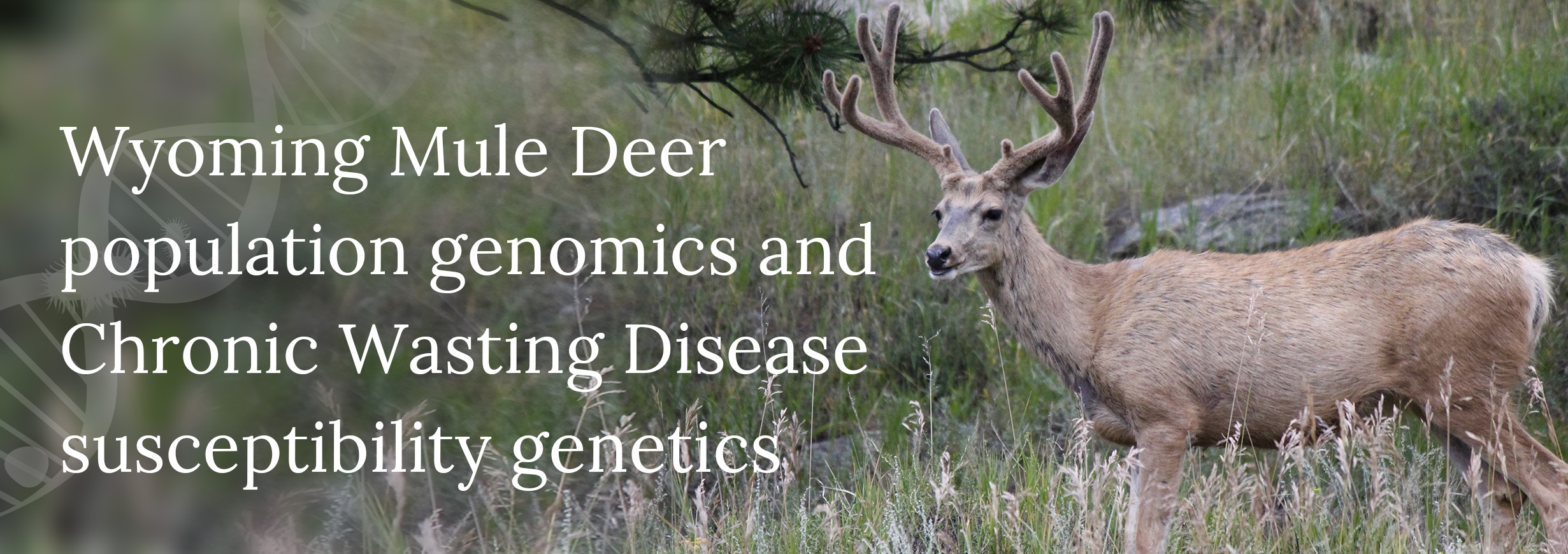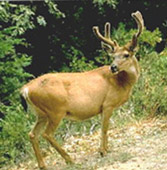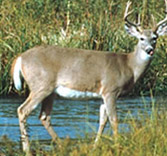Deer
Deer

Investigating Wyoming Mule Deer population genomics and Chronic Wasting Disease susceptibility genetics
 Lab researchers: Holly Ernest, Melanie LaCava
Lab researchers: Holly Ernest, Melanie LaCava
With mule deer declines, and questions of how disease, genetic diversity, migration movements, and land development and use activities in Wyoming are interacting to impact population health and numbers, are more important to address than ever.
Before this new study, there has been no comprehensive statewide population genetic and CWD genotype analysis of Wyoming Mule Deer. Providing such an analysis will allow wildlife agencies including the Wyoming Department of Game and Fish to better manage and conserve Mule Deer by determining: 1) identities of a genetically interbreeding herds statewide of Mule Deer; 2) migration genomics: assessing relationships between individual and herd genetic relatedness and migration patterns; 3) evaluation of barriers to gene flow including highways (including I-80) and other developments; 4) evaluation of herd-specific genetic diversity; 5) estimation of genetic effective population sizes for each herd (numbers of individuals contributing to gene pool); 6) genetic determination of sizes of “populations at risk” for epidemiology of disease threats to Mule Deer in Wyoming (CWD, deer adenovirus, as examples); 7) improved tools and reference data sets for use in poaching cases by the WGFD Forensic lab. These data will form a foundation with which WGFD can monitor the genetic health of Wyoming’s herds into the future. Currently there is no such foundation, therefore no good way to track changes in genetic diversity, herd structure, effective population sizes going into the future.
This project began in 2016 with the start of a sample archive with much help from the Wyoming Department of Game and Fish, University of Wyoming deer researcher groups including the Wyoming Cooperative Fish and Wildlife Research Unit, and the Wyoming State Veterinary Lab. This work will build on key foundations in research including the work of Drs. Matt Kaufmann, Kevin Monteith, Hall Sawyer, Melia DeVivo, Todd Cornish and others. Our mule deer project will augment our other Wyoming ungulate genomics and population health projects (bighorn sheep and pronghorn).
If you would like to help fund and help with this valuable project, please contact Dr. Holly Ernest.

DNA to reconstruct pedigrees of deer with Chronic Wasting Disease
Researchers: Holly Ernest, Bruce Hoar, Jay Well, and Katherine O’Rourke
Molecular genetic data provide powerful tools for genealogy reconstruction to reveal mechanisms underlying disease ecology. Kin-related close social spacing in deer may be a factor in the spread of infectious diseases. Spread of Chronic Wasting Disease (CWD), a prion disorder of deer and their cervid relatives, is presumed to be associated with direct contact between individuals and by exposure to shared food and water sources contaminated with prions shed by infected deer. Key aspects of disease ecology are yet unknown. DNA tools for pedigree reconstruction were developed to fill knowledge gaps in disease dynamics in prion-infected wild animals. Kinship indices using data from microsatellite loci and sequence haplotypes of mitochondrial DNA were employed to assemble genealogies. These molecular genealogy tools will be useful for landscape-level population genetic research and monitoring, in addition to epidemiologic studies examining transmission of CWD in captive and free ranging cervids.
- Spatio-temporal analyses reveal infectious disease-driven selection in a free-ranging ungulate. 2021. Melanie E. F. LaCava, Jennifer L. Malmberg, William H. Edwards, Laura N. L. Johnson, Samantha E. Allen and Holly B. Ernest. Royal Society Open Science.
- Functional connectivity in a continuously distributed, migratory species as revealed by landscape genomics. 2021. Melanie E.F. LaCava, Roderick B Gagne, Kyle D. Gustafson, Sara Oyler-McCance, Kevin L. Monteith Matthew J. Kauffman, Daniel J. Thiele, and Holly B. Ernest. Ecography. Statewide Wyoming study of mule deer population genomics and landscape ecology. Collaboration among institutions and agencies including University of Wyoming, the Wyoming State Veterinary Laboratory, Wyoming Department of Game and Fish, the US Geological Survey, Colorado State University, Arkansas State University, Wyoming Cooperative Fish and Wildlife Research Unit, and others
- Ernest HB, Hoar BR, Well, JA, O’Rourke K. 2010. Molecular genealogy tools for white-tailed deer with Chronic Wasting Disease. Canadian Journal of Veterinary Research.
- New deer mitochondrial DNA haplotype sequences on GENBANK: Accession numbers EF644627-EF644645

